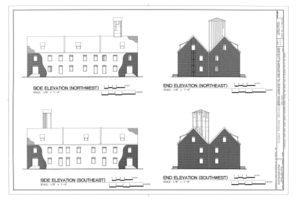File:Dugway Proving Ground, German-Japanese Village, German Village, South of Stark Road, in WWII Incendiary Test Area, Dugway, Tooele County, UT HAER UTAH,23-DUG,2A- (sheet 1 of 3).tif

Original file (14,446 × 9,775 pixels, file size: 280 KB, MIME type: image/tiff)
Captions
Captions
Summary[edit]
| Warning | The original file is very high-resolution. It might not load properly or could cause your browser to freeze when opened at full size. |
|---|
| HAER UTAH,23-DUG,2A- (sheet 1 of 3) - Dugway Proving Ground, German-Japanese Village, German Village, South of Stark Road, in WWII Incendiary Test Area, Dugway, Tooele County, UT | |||||
|---|---|---|---|---|---|
| Title |
HAER UTAH,23-DUG,2A- (sheet 1 of 3) - Dugway Proving Ground, German-Japanese Village, German Village, South of Stark Road, in WWII Incendiary Test Area, Dugway, Tooele County, UT |
||||
| Depicted place | Utah; Tooele County; Dugway | ||||
| Date | Documentation compiled after 1968 | ||||
| Dimensions | 24 x 36 in. (D size) | ||||
| Current location |
Library of Congress Prints and Photographs Division Washington, D.C. 20540 USA http://hdl.loc.gov/loc.pnp/pp.print |
||||
| Accession number |
HAER UTAH,23-DUG,2A- (sheet 1 of 3) |
||||
| Credit line |
|
||||
| Notes |
|
||||
| Source | https://www.loc.gov/pictures/item/ut0568.sheet.00001a | ||||
| Permission (Reusing this file) |
|
||||
| Other versions |
   |
||||
| Object location | 40° 08′ 19.57″ N, 113° 00′ 22.32″ W | View this and other nearby images on: OpenStreetMap |
|---|
File history
Click on a date/time to view the file as it appeared at that time.
| Date/Time | Thumbnail | Dimensions | User | Comment | |
|---|---|---|---|---|---|
| current | 02:46, 4 August 2014 |  | 14,446 × 9,775 (280 KB) | Fæ (talk | contribs) | GWToolset: Creating mediafile for Fæ. HABS 2014-08-02 (3401:3600) |
You cannot overwrite this file.
File usage on Commons
The following page uses this file:
Metadata
This file contains additional information such as Exif metadata which may have been added by the digital camera, scanner, or software program used to create or digitize it. If the file has been modified from its original state, some details such as the timestamp may not fully reflect those of the original file. The timestamp is only as accurate as the clock in the camera, and it may be completely wrong.
| Author | Library of Congress |
|---|---|
| Width | 14,446 px |
| Height | 9,775 px |
| Compression scheme | CCITT Group 4 fax encoding |
| Pixel composition | Black and white (White is 0) |
| Image data location | 375 |
| Orientation | Normal |
| Number of components | 1 |
| Number of rows per strip | 9,775 |
| Bytes per compressed strip | 286,172 |
| Horizontal resolution | 400 dpi |
| Vertical resolution | 400 dpi |
| Software used | ImageGear Version: 13.02.000 |
| File change date and time | 08:30, 16 March 2005 |

